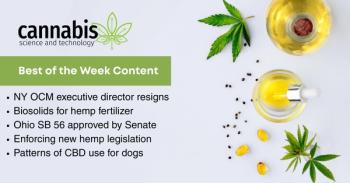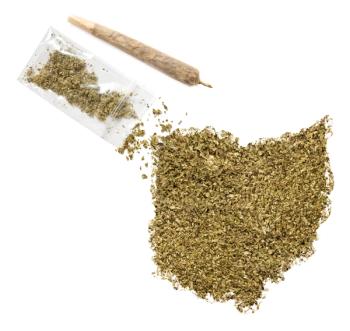
CannMed 2022: Medical Practicum Organizers Share Their Insight, Part I: Dr. Bonni Goldstein
The upcoming CannMed conference—taking place May 3–5 in Pasadena, California—will feature an exciting full-day medical practicum organized by Bonni Goldstein, MD, (the practicum’s originator); Dustin Sulak, DO; Kevin Spelman, PhD, MCPP; and Eloise Theisen, NP, AGPCNP-BC. During this practicum, each of the presenters will share the latest research, their clinical experience, and practice guidelines related to cannabinoid therapeutics.
In this interview series, we speak to each of the organizers to learn more about them and what attends can expect from the practicum. Here in Part I, Dr. Bonni Goldstein shares some of the clinical applications for medical cannabis, dosing information, how cannabis can be used stop opioid addiction, possible ways cannabis might interact with other prescription medications, and how cannabis is used to treat acute and chronic pain, anxiety, ADHD, and pediatric patients. This course is approved by the California Board of Registered Nursing for 9.5 contact hours.**
What are some of the clinical applications for medical cannabis?
Bonni Goldstein, MD: Medical cannabis can be useful for numerous conditions, including managing symptoms of neurodegenerative disorders, inflammatory gastrointestinal conditions, symptoms from cancer and cancer treatment, chronic pain, sleep disorders, and some psychiatric disorders. Because of the widespread distribution of the cannabinoid receptor, we know that the endocannabinoid system plays a role in almost every physiologic process and therefore can be utilized as a target for treatment.
How is medical cannabis dosed and what methods are being used by patients?
Bonni Goldstein, MD: Medical cannabis is different than most pharmaceutical medications, meaning there are no specific dosing recommendations for the vast majority of conditions being treated. Patients are advised to “start low and go slow” to customize their dosing regimen. The reasons for this include a wide inter-individual variation in absorption, metabolism, and excretion of the cannabinoids and other compounds in the plant. However, a clinician knowledgeable in cannabis dosing can help a patient negotiate dosing for the many products on the market, helping to personalize the patient’s dosing regimen. Methods of use include inhalation, ingestion, sublingual, topical, and transdermal applications. Each of these has advantages and disadvantages that can help patients choose their preferred method, although many patients use multiple methods of use depending on symptoms, time of day, and cost.
Can cannabis be used to get you off opioid addiction?
Bonni Goldstein, MD:There are numerous scientific articles that support the concept of cannabis as a substitute for opiates. In a 2017 survey of 2897 medical cannabis patients, 97% reported that they were able to decrease the amount of opiates they consumed when they used cannabis. Additionally, 81% reported that taking cannabis by itself was more effective for their pain than taking both opiates and cannabis together (1).
Another survey found that almost 15% of elderly patients were able to discontinue opioid use within 6 months of initiating medical cannabis (2). Additionally, cannabinoid-based medicines were associated with 17-fold higher odds of discontinuing opioid prescriptions within 21 months (3).
There is also some evidence that cannabinoids may help reduce opioid withdrawal. A 2020 report in the Journal of Substance Abuse Treatmentfound that cannabis alleviated the opioid withdrawal symptoms of anxiety, tremors and trouble sleeping (4). Evidence is also mounting for the use of cannabidiol (CBD) for opioid addiction. In a double-blind, placebo-controlled randomized trial of 42 patients addicted to heroin who were experiencing withdrawal, CBD significantly reduced craving and anxiety compared to those who received placebo (5).
How does cannabis interact with other prescription medications?
Bonni Goldstein, MD: Cannabinoids are metabolized (broken down) for the most part by enzymes in the liver, where many other medications are also metabolized. There can be competition between cannabinoids and other drugs when they are metabolized by the same enzyme, resulting in what is called “drug-drug interactions.” These interactions can result in the blockage of metabolism, leading to accumulation of the drug in the body, which can cause an increase in unwanted side effects. Conversely, the drug-drug interaction may result in an increase in metabolism of a drug, meaning that more drug is broken down faster, causing a decrease in drug levels leading to less efficacy.
It is very hard to predict these drug interactions since there are many differences in the way that people metabolize medications. To avoid any undesirable consequences, the best approach for anyone taking pharmaceuticals who wants to use cannabinoid medicines is to speak with a physician, pharmacist, or other healthcare provider who is familiar with these types of drug interactions.
How is cannabis used to treat acute and chronic pain?
Bonni Goldstein, MD: Cannabis is not a “one size fits all” medicine. How patients use cannabis is determined by many variables, including severity of condition, individual preference, other medications being used, and response to cannabis. For instance, someone who is an experienced user of tetrahydrocannabinol (THC)-rich cannabis may find relief with inhaled THC. Someone who is new to cannabis may find relief with sublingual or ingested cannabidiol (CBD)-dominant cannabis. Others combine CBD and THC in various ratios to customize their treatment. Additionally, cannabigerol (CBG), cannabidiolic acid (CBDA), tetrahydrocannabinolic acid (THCA), and other secondary cannabinoids can be taken singly or in combination to alleviate pain. Each patient must “trial and error” to see how they respond to find the best cannabinoid regimen for their particular physiology and situation. What works best for someone may not work well for another, even if they struggle with the same diagnosis.
How is medical cannabis being used in pediatric patients? Is there clinical evidence for using cannabis to treat anxiety and ADHD?
Bonni Goldstein, MD: Cannabinoid medicines are being used in pediatric patients who suffer with significant illnesses, such as treatment-resistant epilepsy, autism, cancer, gastrointestinal conditions, and genetic syndromes—just to name a few. Since research on the benefits of cannabis in the US is still prohibited due to the Schedule I Controlled Substance classification, scientists and physicians have not been able to study the use of cannabis in any pediatric condition except for epilepsy. However, other countries have allowed research, resulting in preliminary evidence that cannabinoids can help with anxiety and ADHD. One such study from Israel documented that children with autism had improvement in anxiety (as well as improvement in behavior issues and in communication) (6). Another study from Japan found that CBD significantly decreased anxiety in teenagers when compared to placebo (7).
Unfortunately, there are no randomized controlled studies on the use of cannabinoid medicines for ADHD in children, however there are a great many anecdotal reports of benefits by teenagers and adults with this condition who medicate with cannabis. A 2017 trial in adults given either the pharmaceutical Sativex (1:1 CBD:THC sublingual preparation) or a placebo found some improvement in hyperactivity/impulsivity and inattention. Certainly, more studies are warranted for this condition.
To find out more about CannMed’s medical practicum, please visit:
**CONTINUING EDUCATION CREDITS: This course is provider-approved by the California Board of Registered Nursing, provider number 16845, for 9.5 contact hours.
References
- A. Reiman, M. Welty, and P. Solomon, “Cannabis as a substitute for opioid-based pain medication: patient self-report,” Cannabis Cannabinoid Res. 2(1), 160–166 (2017).
- R. Abuhasira, L.B. Schleider, R. Mechoulam, and V. Novack, “Epidemiological characteristics, safety and efficacy of medical cannabis in the elderly,” Eur J Intern Med. 49,44–50 (2018).
- J.M. Vigil, S.S. Stith, I.M. Adams, and A.P. Reeve, “Associations between medical cannabis and prescription opioid use in chronic pain patients: A preliminary cohort study,” PLoS One. 12(11) (2017).
- C.L. Bergeria, A.S. Huhn, and K.E. Dunn. "The impact of naturalistic cannabis use on self-reported opioid withdrawal." Journal of substance abuse treatment 113, 108005 (2020).
- Y.L. Hurd, et al. "Cannabidiol for the reduction of cue-induced craving and anxiety in drug-abstinent individuals with heroin use disorder: a double-blind randomized placebo-controlled trial." American Journal of Psychiatry 176.11, 911-922 (2019).
- A. Aran, et al. "Brief report: cannabidiol-rich cannabis in children with autism spectrum disorder and severe behavioral problems—a retrospective feasibility study." Journal of Autism and Developmental Disorders 49.3,1284-1288 (2019).
- N. Masataka, "Anxiolytic effects of repeated cannabidiol treatment in teenagers with social anxiety disorders." Frontiers in psychology 10, 2466 (2019).
Newsletter
Unlock the latest breakthroughs in cannabis science—subscribe now to get expert insights, research, and industry updates delivered to your inbox.





